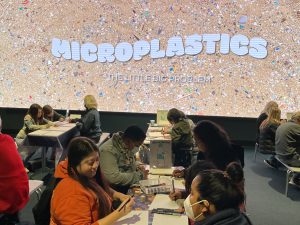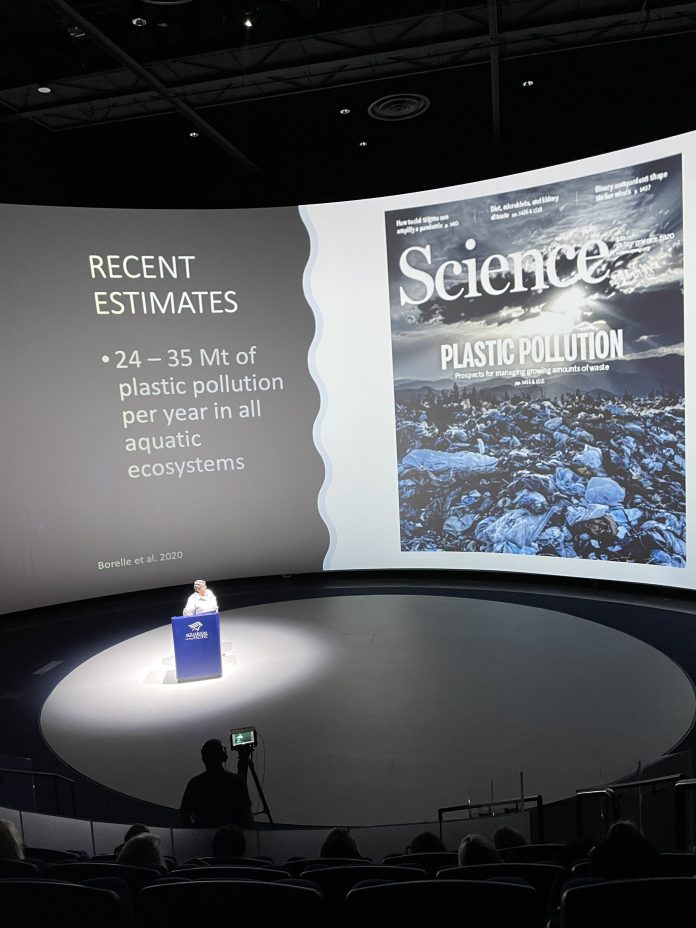The next time you open a plastic water bottle, you should realize that microfibers of plastic have likely slipped into the water you are about to drink.
So says Shelly Moore, Executive Director the Moore Institute for Plastic Pollution Research. Moore, who was the guest speaker at the Aquarium of the Pacific’s First Wednesday lecture series this past week, is incidentally not related to the founder of that institution said Dr. Peter Karevia, the Aquarium’s President said.
Charles Moore reportedly founded the Moore Institute after returning by boat from Hawaii a few years back and upon seeing mountains of floating plastic, coined the term “the Great Pacific Garbage Patch.”
“The younger crowd knows plastics as the bane of the planet,” said Karevia, “and in fact, plastics is the devil we know and the devil we love because they made fresh food possible. They help feed the world,” he said, “and they’ve done so many positive things for us.”
Karevia said Shelly Moore has been working on water quality, microplastics, trash, and marine debris for most of her career,” said the Karevia.
Shelly Moore, who has researched ocean plastics and micro plastics for most of her career, said plastics have indeed provided benefits to the world, but are suddenly, and exponentially, becoming a huge problem for the world’s oceans.
“What we’re facing going forward,” she said, “is basically there is a ton of plastic and most of that makes it into landfills where it just sits for years and years and years. It doesn’t really go away. Many of the plastic items that we have today take years and years and years on the magnitude of hundreds of years to degrade. It just doesn’t go away.”
Moreover, Moore said growing amounts of plastics are annually making it into aquatic environments that will not set well with the future.

Courtesy photo
“We’re going to have a legacy that we’re going to leave for future generations,” said Moore, “that isn’t going to be so nice.”
“We’re producing plastics so fast that we can’t really deal with the waste that comes from the plastic products we’re using,” she warned.
More than the plastics most people can see, said Moore, is the pre-production plastic pellets called “nurdles,” which are four to five millimeters in diameter. “They come in different shapes and sizes,” she said.
“Those are actual precursors to plastic products,” said Moore. She said the tiny pellets come in various plastic packaging and are unknowingly carried by beachgoers and deposited in the sand.
In one of two studies referenced by Moore, she said they found hundreds of “nurdles” in every five-gallon bucket of sand samples taken from the beaches in Orange County during one of the studies.
“We estimated there are over 100 million nurdles in Orange County alone,” the researcher said.
Moore said the nurdles came from everything from Starburst candy wrappers to Marlboro cigarettes.
Some state Water Boards have instituted innovative programs such as “Clean Sweep” to remove some of the microplastics from the beaches, she said, noting also that California has outlawed some of the tiniest microbead carriers.
“Basically, you can generally find nurdles on the beach anywhere in California,” she added, but they are more concentrated in areas where plastics are being produced.
Nevertheless, plastics and microplastics easily make their way into the ocean’s ecosystem.
“By the year 2030,” said Moore, “we are going to see a cargo ship worth of plastics, by weight, entering into our aquatic environments every day,” she predicted
“We have a number of pathways,” for plastics to enter the oceans, she said, including stormwater drains, which are expressways for plastics to enter the ocean.
“Every major rain event moves large numbers of microplastics down the storm drains into the ocean,” said Moore, after which naming a list of other pathways through which plastics reach the ocean.
Further, she said humans, and the oceans, are slowly being contaminated by microplastics and microfibers.
“We’re breathing plastic every day,” she added. “If you have carpet in your house, curtains made of synthetic materials, you are likely breathing microfibers,” said Moore.
She said opening the cap of bottled water will also more than likely deposit a few microfibers of plastics into the water that then comes from the bottle.
“The mismanagement of plastic waste is a huge problem,” said Moore. “We don’t yet know the full impact they have on the human body,” she said.
Though no extended study has been done, there are hints that plastic microfibers to potential limits the production of estrogen in women.
Standards for microplastic-free drinking water are being developed, she said, and she said there is now a team working with Charles Moore.
They have recruited a new team and have dedicated themselves to “bringing to light the problems of microplastics in our biosphere.” Their work with trace high tech polymer detection and use high end microscopes to become the first nonprofit to be able to analyze complex polymers.
With grant funding from The Possibility Labs and California 100, they will be working with U.C. Berkeley and Cal State Long Beach to develop the first ever data portal for mircoplastics.
They have opened a laboratory in Alamitos Bay on the border between Seal Beach and Long Beach where professors will work with students and will encourage students to collaborate, she said.
In addition, Moore went through a number of solutions to the plastics problem, including a burgeoning “BYO” Bring Your Own industry in which diners, for instance, bring their own plastic wear so and reuseable containers for shampoo and other personal items that routinely use, and discard plastic.
She said discarded take out food containers are among the greatest plastic polluters of the modern generation.
Moore invited participants to visit the Bring Your Own store in Long Beach and do research to see what each citizen can do to reduce the problem of plastics filling our oceans.
“Find out what you can do to help,” she urged.
Moore’s entire presentation is also available for viewing on YouTube.

